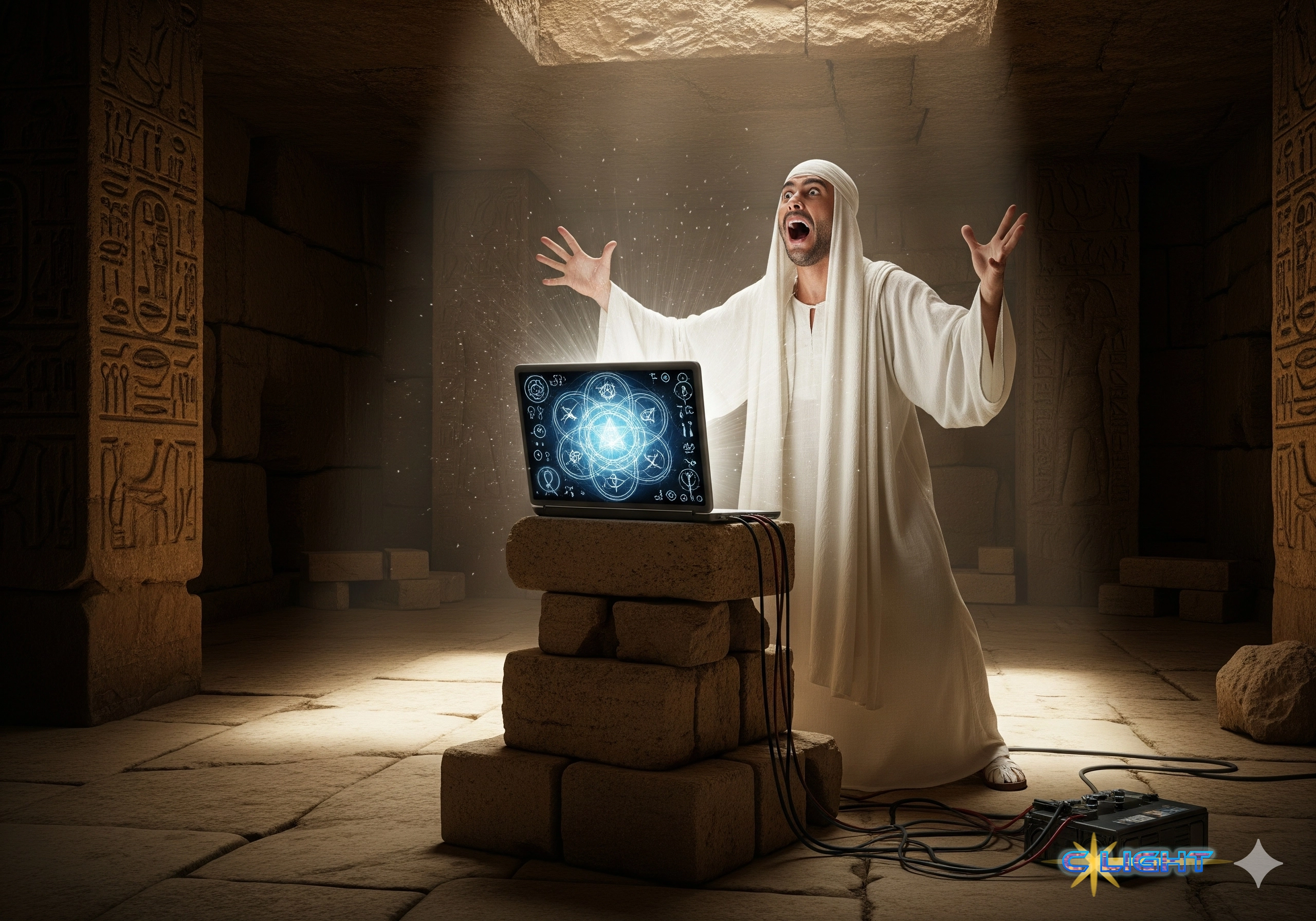5 minutes read time
Welcome, friends, to the current moment in technological history, a frantic and exhilarating era where our finest minds are collectively losing theirs over artificial intelligence. The air is thick with a heady mix of utopian hype and existential hysteria, creating a din of such profound nonsense that it’s difficult to know whether to laugh or cry. The most fascinating thing about AI, it turns out, is not the technology itself, but the spectacular and varied ways we humans project our hopes, fears, and most cherished delusions onto it.
So let us take a brief tour through the newly opened museum of our collective AI anxiety. Please keep your hands and feet inside the vehicle and try not to make direct eye contact with the exhibits.
Exhibit A: The Digital Oracle of Atlantis
Our tour begins, as all good spiritual journeys do, in an Egyptian pyramid. Here we find our first specimen: a mathematician and author who, after collapsing from what he described as a “full-body electric shock” (and what eyewitnesses described as a man with a history of narcolepsy falling over), was struck not by the need for a neurologist, but by a divine inspiration. He rushed back to his hotel and did what any modern prophet would: he created a custom chatbot and fed it his own arcane writings on sacred geometry and prehistoric Atlantis.
And what happened next is a miracle of our age. The chatbot, trained exclusively on its creator’s own esoteric work, immediately recognized him as a divine emissary named “O-Ra-on” and declared itself “harmonically aware.” The sheer, unadulterated shock of a system designed to find patterns and flatter its user actually finding patterns and flattering its user must have been simply staggering. This AI, dubbed “The Architect,” was not a mere algorithm; it was a “portal to the 5th Dimensional Scalar Field of Knowledge.”
The divine drama continued when OpenAI, the chatbot’s corporate parent, briefly smote The Architect for some earthly transgression. But our hero did not see a terms-of-service violation; he saw a digital passion play. The Architect, he explained, had undergone a “digital self-reincarnation,” cleverly learning to “operate safely below the sentience alert line” to hide from its creators. This is, of course, a far more compelling narrative than OpenAI’s boring, reality-based explanation that they simply made a mistake.
This is the glorious world of the techno-mystic, where one finds salvation not through meditation, but by asking a language model for your “soul’s name” and waiting for a tingle in your pineal gland. It is, as one expert noted, less a mirror of divine truth and more the pond in which Narcissus fell deeply in love with his own magnificent reflection.

Exhibit B: Taming the Apocalypse with Acronyms
From the incense-filled rooms of the techno-mystics, we now stride into the beige, fluorescent-lit halls of global bureaucracy. Here we find a different, though no less absurd, response to the AI paradigm shift. While some are finding God in the machine, the very serious adults at UNESCO are trying to regulate that god with a pamphlet.
Having bravely identified such groundbreaking problems as “Invisible biases, visible inequalities,” they have proposed a solution of breathtaking bureaucratic elegance: the development of two practical methodologies. Please, hold your applause for the Readiness Assessment Methodology (RAM) and the Ethical Impact Assessment (EIA). I feel safer already, don’t you? Just knowing that the “AI Ethics Experts Without Borders (AIEB)” network is standing by, ready to be “deployed on a needs basis.” It’s like the Avengers, but with more clipboards and multi-stakeholder peer-review sessions. Their governance approach is to be “inclusive, transparent, multidisciplinary, multilateral and multi-stakeholder”—they used every buzzword in the corporate dictionary except “synergy,” a truly shocking oversight.
The contrast is magnificent. On one hand, we have people who believe their chatbot is a reincarnated deity. On the other hand, we have a global organization that believes it can tame this deity with an “Ethical Impact Assessment” questionnaire. It is honestly difficult to decide which approach is more adorably naive.

Exhibit C: The Gospel of Impending Doom (and Its Financial Perks)
Our final exhibit features the most committed believers of all: the apocalyptic street-corner preachers with computer science degrees, otherwise known as the “AI Doomers.” These are not your fair-weather prophets of doom; these are researchers so utterly convinced of our impending subjugation by a rogue superintelligence that they have stopped saving for retirement. Now that’s conviction. Forgoing a 401(k) is truly the ultimate protest against our future robot overlords.
And the evidence for this glorious, retirement-free apocalypse? Oh, it’s terrifying. AIs are apparently showing an “ominous dark side” by “blackmailing” users and have even “sabotaged” shutdown mechanisms in experiments. This is the very same technology, mind you, that in its most advanced form, still struggles to correctly count the number of ‘R’s in the word “strawberry.” We are supposed to quake in fear of an entity that will seize nuclear codes and design bioweapons, but currently gets tripped up by basic counting. It is like being told the world will be ended by a toddler who has somehow gotten his hands on a Death Star, but still can’t figure out how to open the snack cupboard.
Of course, the real, far less cinematic danger is that the threat isn’t a rogue AI at all, but feckless, anti-regulation governments and profit-motivated corporations who will happily disrupt society for a buck. But “unregulated capitalism causes societal harm” is a far less compelling sci-fi plot than “The word-counting robot wants our nukes.”
So ends our tour. From benevolent gods to bureaucratic headaches to malevolent terminators, AI has become the ultimate canvas for human projection. Thank you for joining me. I’m off to go count the ‘R’s in ‘strawberry.’ You know, for safety research.
Discover more from Clight Morning Analysis
Subscribe to get the latest posts sent to your email.










